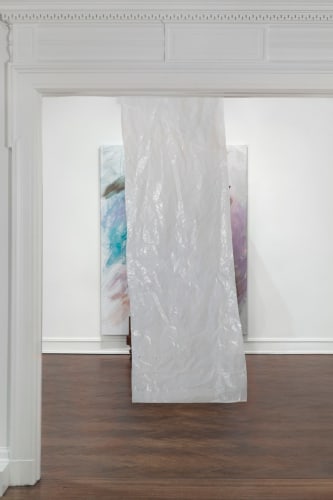
By: Kim Levin
African American conceptualist David Hammons doesn't play by the rules: no press releases, no titles, no artist statements. He makes himself scarce and doesn't attempt to explain his work or his materials (elephant dung, basketball hoops, chicken wings, gnawed barbecue bones, cheap-wine bottles). But then, he doesn't have to. His art - not about the mostly white art world, but about the black expereince in the United States - is not meant for the art community, but for the street. His most famous work is a 1983 performance piece titled Bliz-aard Ball Sale, in which he peddled snowballs in three sizes alongside the street vendors in New York's Cooper Square. His sarcasm about esthetics has cultural overtones that largely explain themselves. In 2002, for his sublime Concerto in Black and Blue, he blacked out the huge spaces of the now-defunct Ace Gallery in New York and gave visitors tiny flashlights that glowed blue. As people made their way through the inky darkness, they looked at, well, nothing at all except the tiny blue lights of other peoples' flashlights. Was this piece color-blind or did Hammons turn us all into the "Invisible Man"? His 2007 show in L&M's elegant townhouse was little more than a bunch of ratty fur coats crudely daubed with paint.
For the big, gestural paintings in this show, which featured work from 2008 through 2010, in lavendars, oranges, and silver, Hammons embraces a kind of neo-Abstract Expressionist style. But the paintings themselves were barely visible: Hammons did his best to cover them with worn, torn, ripped, and slashed translucent or opaque plastic tarps; raggedy blue or black garbage bags; or sickly green polyester. He even hung an awkward piece of plastic in an entranceway. A bulky old armoire with its back to viewers pressed against one canvas. Another painting had a tan towel glued to its surface. But the most thrilling works, installed upstairs, skipped the painting conceit entirely, consisting soley of layered sheets of plastic. If Hammons can't take his art to the street, he takes the streets to his art.
These distressed works may evoke Robert Morris's felt sculptures, but they also challenged the gallery's pristine environment by insisting on the dirty and worn inner-city reality. Socially, they signify poverty and an African American tradition, forged from making the most of hand-me-downs, leftovers, and the cheapest scraps of protein available. Modern art is said to have originated when Picasso stole the forms of African tribal sculpture in order to fashion an art that was unencumbered and abstract. One century later, Hammons lures us back to the spirtual, political, and utilitarian origins of art. Conceptually radical, these works appeared here accidental, intrinsically moral, and breathtakingly enigmatic and beautiful.